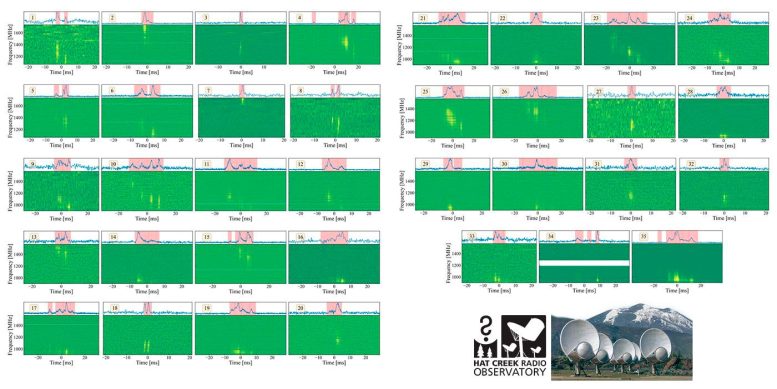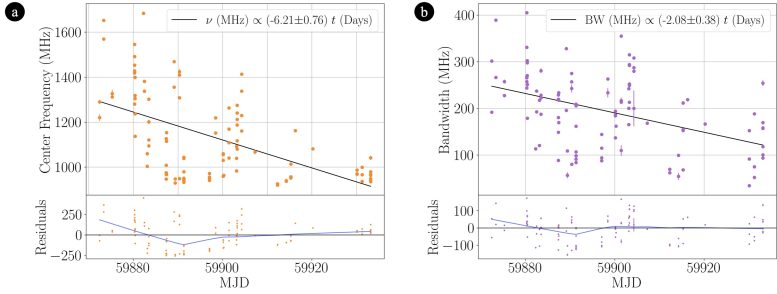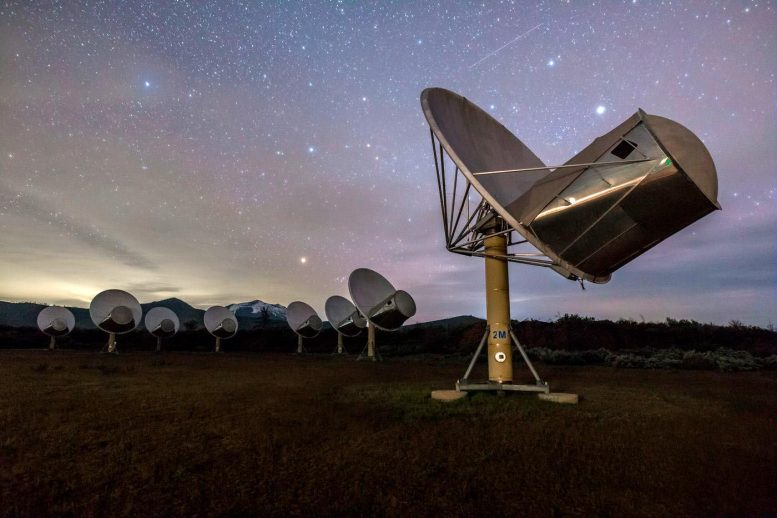Researchers at the SETI Institute have detected 35 bursts from FRB 20220912A using the Allen Telescope Array, shedding light on the mysterious nature of fast radio bursts and their possible origin from extreme cosmic objects. Credit: SciTechDaily.com
This work demonstrates that new telescopes with unique capabilities like the ATA can provide a new perspective on one of the great mysteries in FRB science.
A team of SETI Institute scientists has released new insights into a cosmic mystery called Fast Radio Bursts (FRBs). The discovery and detailed observation of repeating FRB 20220912A at the SETI Institute’s Advanced Allen Telescope Array (ATA) shed light on the nature of these space signals.
FRBs are brief, intense flashes of radio waves from deep space. While most happen only once, some “repeaters” send signals more than once, which adds to the intrigue of understanding their origins. In 541 hours of observation, the researchers detected 35 FRBs from repeater FRB 20220912A. Observations made using ATA covered a wide radio frequency range and revealed fascinating patterns. All 35 FRBs were observed in the lower part of the frequency spectrum, each with its own unique energy signature.

Dynamic spectra (or “waterfall” plots) for all bursts from FRB 20220912A were detected using the Allen telescope array, frequency-averaged pulse profiles, and time-averaged spectra.
The red-shaded areas in the time series plots indicate the duration of the defined suberuption, while the red vertical lines indicate the adjacent suberuption. Credit: SETI Institute
Insights from the SETI Institute’s observations
“This work is exciting because it provides both confirmation of known FRB properties and the discovery of some new ones,” said the SETI Institute’s Dr. said Sophia Sheikh, NSF MPS-Ascend Postdoctoral Fellow and lead author. “We’re narrowing down the source of FRBs, for example, to extreme objects like magnets, but no existing model can explain all the properties observed so far. It’s exciting to be part of the first FRB study done with ATA – new telescopes with unique capabilities like ATA’s will shed light on great mysteries in FRB science. This work demonstrates that a new angle can be provided.
Detailed findings, recently published in the journal Monthly Notices of the Royal Astronomical Society (MNRAS), show intriguing behaviors of FRBs. These mysterious signals exhibit downward frequency drifting, coupling between their amplitude and center frequency, and changes in burst duration over time. The team also noticed something previously unreported: a significant drop in the central frequency of bursts over two months of observation, revealing an unexpected cosmic slide-whistle.

Two FRB 20220912A dataset parameters – central frequency and bandwidth – are plotted over time in the MJD, from the start of the campaign to the end of the campaign (approximately 60 days). Panel a) indicates that the central frequency of the FRB decreases through the propagation (the residuals of the fit and the lower non-parametric orientation are shown in blue below). Panel b) shows the same decrease over time for bandwidth. Credit: SETI Institute
In addition, the researchers used these observations to predict the cut-off point for bright bursts of FRB 20220912A, indicating its contribution to the overall cosmic signal rate. In fact, this particular object was responsible for a few percent of all the strongest FRBs in the sky during these observations.
The study also examined the time patterns of burst sequences, looking for recurrences within and between FRBs. No clear patterns were observed, highlighting the unpredictability of these celestial events.
Part of the Allen telescope series
This work demonstrates the key role of ATA in decoding the mysteries of FRBs. ATA has the unique ability to simultaneously record a large number of frequency channels, even if they are widely separated – for example, some frequencies are very high and others very low. This allows immediate tests when the FRB arrives to control what the FRB is doing at high and low frequencies simultaneously. Current upgrades promise even more capabilities, simultaneously seeing faint FRBs at even higher frequencies, ensuring ATA remains at the forefront of advancing our understanding of FRBs.

Allen Telescope Array (ATA) at Hot Creek Radio Astronomy Observatory, California, USA. ATA is operated by the SETI Institute and is designed as an instrument dedicated to technosignature searches, a powerful facility for the study of transients. Credit: Joe Marfia
“It’s exciting to see ATA engaging in FRB research three years after its upgrade program began,” said SETI Institute ATA Project Scientist and Co-author Dr. Vale Farah. “ADA has unique capabilities that are being used in many research endeavors, including fast interpolation.”
This landmark discovery marks a significant step in the ongoing quest to unravel the secrets of extreme matter in the universe. As scientists continue to explore the universe, each unique feature we discover brings us closer to understanding the origin and nature of these fascinating cosmic signals.
Note: Sophia Z. David R. DeBoer, Vishal Gajjar, Bill Karn, Jamar Kidling, Wenbin Lu, Mark Masters, Pranav Premnath, Sarah Scholtz, Carol Schumacher, Gurmehar Singh, and Michael Snodgrass, accepted. Monthly Notices of the Royal Astronomical Society.
arXiv:2312.07756

“Friend of animals everywhere. Devoted analyst. Total alcohol scholar. Infuriatingly humble food trailblazer.”